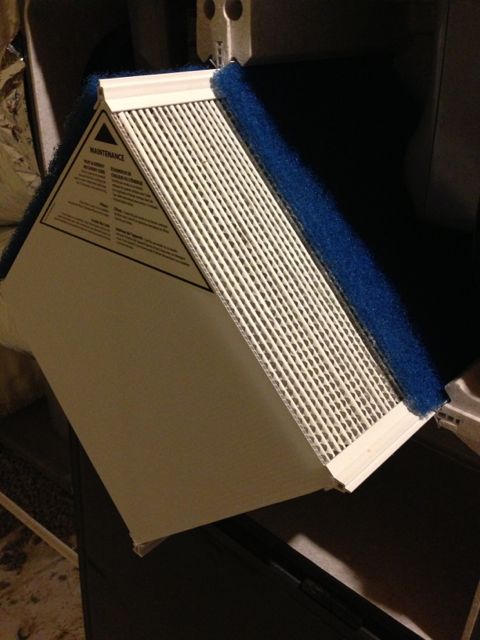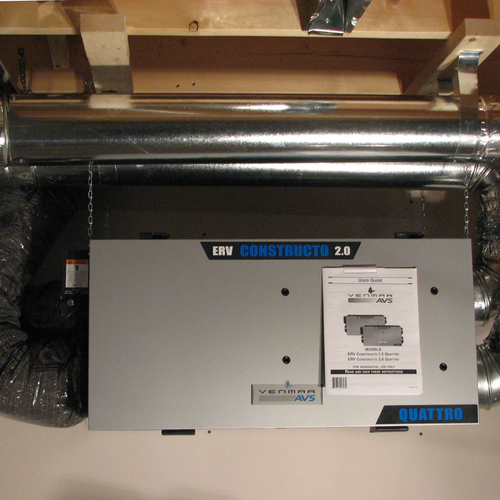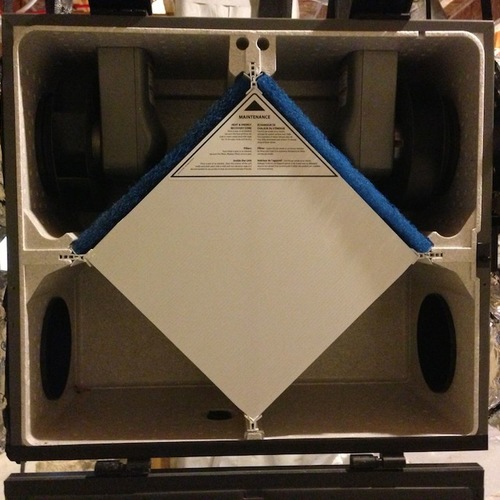
One of the most frequently asked questions regarding the type of balanced ventilation devices known as the energy recovery ventilator (ERV) and the heat recovery ventilator (HRV) is: “Can I get that in red?” OK, not really. Everyone knows that most people prefer their ventilation systems in blue. The real question that gets asked a lot, however, is whether to get an ERV or an HRV. As you know already from the title, my take is that you probably need an ERV, not an HRV.
Climate and occupancy
Deciding between an ERV and an HRV should land on ERV for most people in most places. In a warm humid climate, an ERV brings in less outdoor humidity than an HRV. (Note: an ERV is not a dehumidifier. It does still add to the latent load in the house.) In a hot-dry climate, an HRV will make your already dry air even drier, sending your precious water vapor out into that desert air. In a cold climate, bringing in outdoor air without moisture exchange can result in extremely low humidity in winter because cold air is dry air. On the basis of climate, it’s only in mild climates where it doesn’t get too cold, too humid, or too dry where HRVs make sense . . . sometimes. That’s why they’re popular in the Pacific Northwest.
Occupancy, though, is another important factor to consider. The higher the density of people in a space, the more you might need to dry out the air with an HRV. A small, airtight apartment or condo with two or three people in it, for example, may be too humid indoors with an ERV. In a dry or cold climate, this works year-round. In a humid climate, it works in the winter, but an ERV would work better for the warm, humid days.
History, efficiency, and core swapping
Some people think HRVs are the way to go because older ERVs didn’t have good control over frost forming on the core. That’s not the case anymore. ERVs work fine in really cold places now. Another reason people choose HRVs is that they’re more efficient at transferring heat than are ERVs. What good is it to have high-efficiency ventilation, though, if you end up growing mold or going through 50 liters of skin lotion each year?

Another possibility is to do both. If you’re in a humid climate and don’t want to bring in a lot of water vapor with your summer ventilation, you need an ERV. But if your house is very airtight, you may get too humid indoors in winter with an ERV. In that case, you could have an ERV core for the summer and then swap it out with an HRV core for the winter. (Not every manufacturer makes models with swappable cores, so check the one you’re buying if you think you may want to do this.)
The primary way to choose between an ERV and an HRV is to understand the moisture control needs of the space being ventilated. In general, when the outdoor air is significantly drier or more humid than indoor air, you should go with an ERV.
_______________________________________________________________________
Allison Bailes of Atlanta, Georgia, is a speaker, writer, building science consultant, and the founder of Energy Vanguard. He has a PhD in physics and writes the Energy Vanguard Blog. He is also writing a book on building science. You can follow him on Twitter at @EnergyVanguard. Photos courtesy of author.
Weekly Newsletter
Get building science and energy efficiency advice, plus special offers, in your inbox.















28 Comments
Who are the "some manufacturers" that offer swappable cores? It's not something I've seen commonly advertised -- I think I've only seen it from Zehnder
Jonny,
I think Venmar does too.
Broan cores are swappable as far as I can tell.
I have a swappable core and own both ERV and HRV cores. Here in New Hampshire, I definitely need the ERV core in in the winter, to keep if from getting too dry--in fact it gets a little too dry even with the ERV core. And I want the ERV core in the summer, to bring in less of the outdoor humidity. In the spring, either is fine, so I don't bother, but in the fall, after the summer leaves the house with more moisture than I'd like, I put in the HRV core for a few months until the humidity inside gets down to where I'd like it, and then swap back to the ERV for the rest of the year. I'm not sure it's worth owning both for those few months, but when I'm glad to have that capability when I do use it.
I think part of the story is that recommended ventilation rates have gone up, and at those higher rates, a typical house in a cold climate will get too dry in the winter.
What brand is yours, Charlie?
Zehnder.
Charlie,
Would a whole-house dehumidifier work as well? Is that something you have or think might work instead of swapping the cores?
Thanks,
Adam
Sure, a whole house dehumidifier would avoid every needing a HRV to help with removing humidity. But the HRV does it with no energy input other than what you need for the ventilation whereas a dehumidifier is much more energy intensive.
Charlie, Thanks for the real-world experience. Do you by any chance have blower door data on your house? Size and # of occupants would help too, but that's getting a bit personal....
I've been considering this question quite a bit lately as I design my own zone 6 house. Clearly, a small, tight house with a bunch of people inside is going to behave differently than a large one with nobody home. I think the threshold between too wet and too dry is going to be right in between those extremes. It's probably best to select a system that has swappable cores just in case in cold climates. For nearly everybody else, the headline is still probably correct.
2364 square feet, 2 people, something like 2 ACH50. It's a retrofit and we sealed a lot of air leaks but the remainder are not negligible. If you want I could look up the actual blower door number and the commissioning data for the actual ventilation rates.
I am curious ... if during heating season outdoor temperature is above dew point of the indoor air, would there be any moisture transfer in an ERV core?
It all relates to dewpoints. If the dewpoint of the indoor air is higher than the dewpoint of the outdoor air, an ERV will transfer moisture to the incoming air (this is the most likely scenario with cold outdoor temps in winter).
In the summer the opposite will happen (as long as the house has air conditioning and/or dehumidification); the dewpoint of the indoor air will be lower than the dewpoint of the outdoor air, and the ERV will pull moisture out of the incoming air.
From: https://www.ashrae.org/file%20library/technical%20resources/covid-19/si_s20_ch26.pdf
"The second law of thermodynamics states that heat energy always transfers from a region of high temperature to one of low temperature. This law can be extended to say that mass transfer always occurs from a region of high vapor pressure to one of low vapor pressure. The conceptual energy recovery exchanger in Figure 1 facilitates this transfer (without mixing supply and exhaust airstreams) across a separating wall (shown by a thick horizontal line in Figure 1) made of a material that conducts heat and is permeable to water vapor. Heat is transferred when there is a difference in temperature between the two airstreams. Moisture is transferred when there is a difference in vapor pressure between the two airstreams."
Thanks for the link!
so... the ERV recovers some relative humidity. why not just say so. some number would be great ranges of recovered energy/ humidity....
“[Deleted]”
well, in the context of my question it was important to understand that even though when there is no condensation occurring during the ERV operation, moisture transfer still exists and the quote that Tyler provided explains how that happens. As far as the amount of moisture transferred in this case goes I think it is very much dependent on the material of the ERV core and overall is not significant.
I believe that some manufacturers will provide data, but it is often not in great detail. My understanding is that the effectiveness of the system to transfer of humidity (water vapor) is similar the effectiveness to transfer heat/cold.
If you run your system at the higher end of the range allowed by the system (ERV or HRV), the rate of effectiveness decreases. In my research, different brands and models will offer varying degrees of control over the fan speed. My own ERV (Panasonic Intellibalance 100 cold climate) allows me to controls the fan speed with 50-60-70-80-90-100 CFM per hour.
I could be wrong but maybe something you can verify when doing your research.This is important because you may choose to buy a larger capacity system and run it at the lower end of the speed setting. This could have the greatest impact on the performance (i.e. how ERV transfers humidity) than any other factor.
Does anyone have any suggestions about what ERV to buy? I am looking for a unit capable of 60-80 cfm. Panasonic? Broan? Renewaire? Other? Not looking for a Zehnder. I can compare statistics but real world feedback would be very helpful.
Thanks.
I love my Panasonic Intellibalance 100 - the cold climate version. I suggest that you look at the Intellibalance 60-200 with the idea of running it at the lower speed range. This will significantly increase the rate of efficiency of the unit but more important it will improve the effectiveness. It also significantly reduces the noise produced by the units. Whatever you choose, I suggest to select something that you can run at the lower end of the fan speed.
Just be aware when running wire to control the boost mode that the Panasonic unit - unlike many others - allows a 120V current to run through the wires. When I called Panasonic, they told me to use regular 120V switches to control the boost mode - something you should verify yourself.
The Panasonic is rated as a very quiet unit, but mine is installed inside the living spaces so I took precautions just the same. I also run my unit at 100 CMF. The controls allow for manually controlling the CFM rate with knobs.
If you are at all worried about the sound levels of ANY ERV/HRV unit you install, I stronly suggest you look into HVAC silencers. I installed 4 of these silencers on my unit, one on each outlet. I also used these on my remote hoodvent fan and I am very happy with the results.
Panasonic IB100 is running very efficiently at 60cfm.
Next spring we are looking to build a Log Home in Tennessee, it will have a walk-out basement +-1120 SF the main level is also 1120 SF, and there is a loft of +-650SF. I will be install Hydronic Heat using Warmboard Comfort System in the floors of all 3 levels. I will also want an HVAC system for AC. The house will be built to very air tight tolerances with R-60 roof using SIP's. The ceiling will be a cathedral style with exposed timber rafters and 2x6 decking which the SIP assembly will lay on. The roof will be a metal roof. There will be a vapor barrier between the 2x6 deck and the SIP and the roof will be become a "warm roof" as the metal roofing will be vented by use of vertical strapping. I am looking at the Panasonic Intelli-Balance 200 Balanced Air Solution 60-200 CFM ERV as one of the choices to recommend to my contractor. I have not seen a lot of reviews on this ERV -- is it a fairly new offering in the ERV world?
In case anyone isn't looking closely, that's Essay Rev(ise) not Easy ERV. I am afraid Nancy is a spam bot.
Charlie,
The Q&A has been inundated by spam the last couple of days.
Charlie and Malcolm,
Sorry for the spam. I've deleted this instance.
Martin,
It sure wasn't a complaint. I'm just disgusted they put their commercial interests above those of the GBA posters who use the site - and it must be really annoying for you editors to deal with.
Thanks for the insight passive.
In fact, I ordered the 100 unit a little over a week ago after finding generally favorable comments. I expect I will run the unit at 60-70 cfm so hopefully efficiency factors vs fan speed will work out.
The efficiency and effectiveness ratings for these.units is very good so I am sure you made the right choice.
Log in or create an account to post a comment.
Sign up Log in